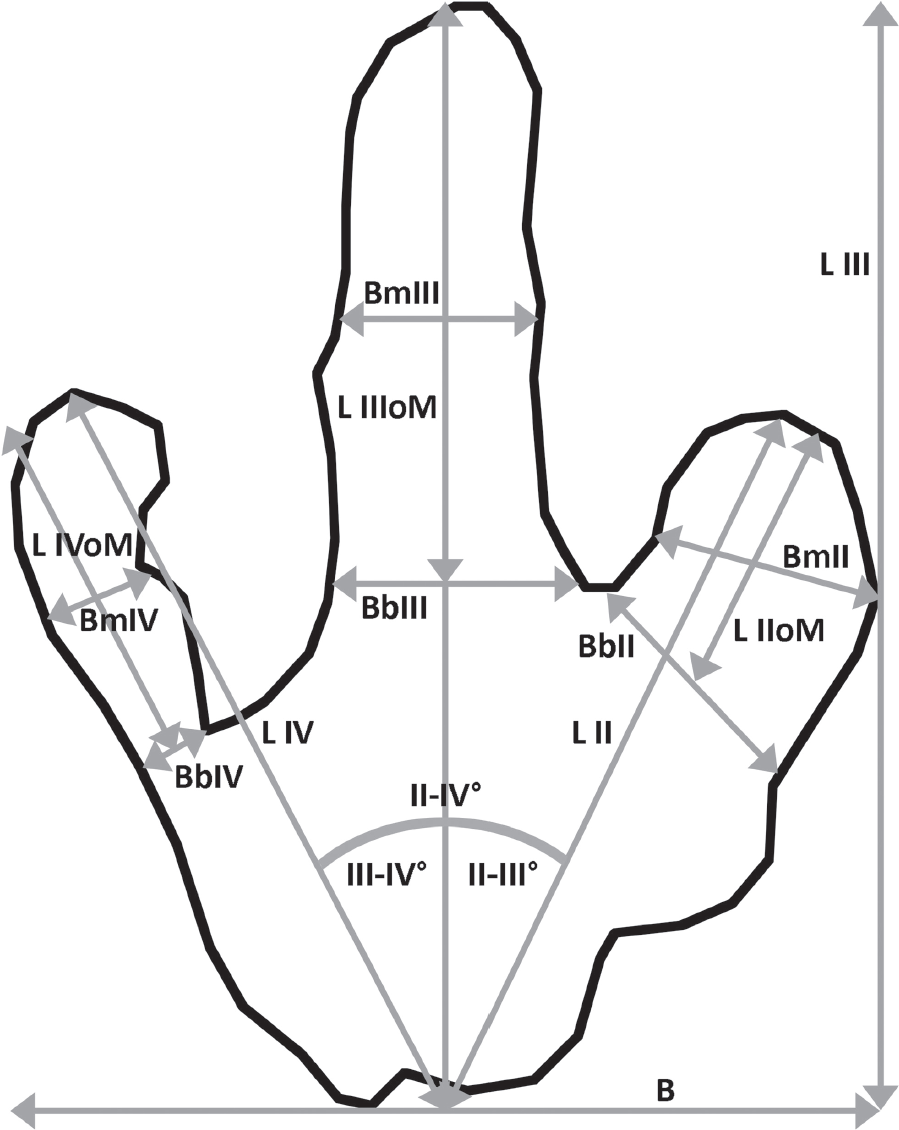
16.1. Sketch of track 1/3 showing locations of the measured distances taken for quantitative analyses. Abbreviations: LII, length along second digit; LIII, length along third digit, the same as total track length; LIV, length along fourth digit; B, total track width; LIIoM, length of second digit without metatarsal; LIIIoM, length of third digit without metatarsal; LIVoM, length of fourth digit without metatarsal; BbII, width at proximal third or base of second digit; BbIII, width at proximal third or base of third digit; BbIV, width at proximal third or base of fourth digit; BmII, width at mid length of second digit; BmIII, width at mid length of third digit; BmIV, width at mid length of fourth digit; II–III°, divarication angle between digits II and III; III–IV°, divarication angle between digits III and IV; II–IV°, divarication angle between digits II and IV.
Elusive Ornithischian Tracks in the Famous Berriasian (Lower Cretaceous) “Chicken Yard” Tracksite of Northern Germany: Quantitative Differentiation between Small Tridactyl Trackmakers |
16 |
Tom Hübner
THE “CHICKEN YARD” TRACKSITE IN NORTHERN Germany, stratigraphically located in the Berriasian (lowermost Cretaceous) Bückeberg Formation, is famous for the extraordinary abundance of typical tridactyl theropod dinosaur tracks and the first didactyl footprints of deinonychosaurian theropods from Europe. Among the vast number of theropod tracks, there are a few small tridactyl tracks, which usually differ from the former by weaker mesaxony, wider divarication angles, stronger symmetry, broader digits, and a rounder and more consistent metatarsal imprint. These features indicate ornithischian track makers, but the strong morphological variation often hampers unambiguous differentiation from less well-preserved theropod tracks. Thus, measurements of the possible ornithischian tracks were quantitatively analyzed to identify potential common features among the ornithischian tracks as well as differing features setting them apart from small theropod tracks. The weaker mesaxony and broader digits are therefore interpreted as diagnostic features of the ornithischian tracks, but other dimensions have no significance in this respect. However, these results imply that the standardization and combination of data sets from a larger number of tracksites around the world will lead to a much better secured discrimination between small tridactyl trackmakers.
INTRODUCTION
The differentiation between ornithopod/ornithischian and theropod tridactyl tracks is a long debated and still not satisfactorily resolved problem in the field of paleoichnology (e.g., Moratalla, Sanz, and Jiménez, 1988; Thulborn, 1990, 2013; Lockley, 1991, 2009; Farlow and Lockley, 1993; Foster and Lockley, 1995; Farlow and Chapman, 1997; Azuma et al., 2006; Mateus and Milàn, 2008; Gierlinski, Niedzwiedzki, and Nowacki, 2009; Belvedere, Mietto, and Ishigaki, 2010; Martin et al., 2011; Romilio and Salisbury, 2011; Castanera et al., 2013; Romilio, Tucker, and Salisbury, 2013; Xing, Liu, et al., 2014). The problem is on the one hand affected by the similar pes anatomy of both groups and on the other hand by significant variation in shape and dimensions of tracks, even within a single trackway, due to preservation (e.g., Thulborn and Wade, 1984; Manning, 2004; Henderson, 2006; Milàn, 2006; Milàn and Loope, 2007; Romilio and Salisbury, 2011; Romilio, Tucker, and Salisbury, 2013; Thulborn, 2013). The tracks of small ornithischians are especially difficult to identify when preservation is poor. However, in the case of good preservation, some unambiguous features do exist, including: the existence of manus imprints; an anteriorly directed and long first digit (in theropods, it is relatively short and often directed medially or posteriorly – the hallux); the absence of sharp and offset claw marks; strong symmetry of the track; wide digits with only a small number of weak digital pads; and a rounded, wide metatarsal “heel” imprint (e.g., Moratalla, Sanz, and Jiménez, 1988; Thulborn, 1990; Stanford, Weems, and Lockley, 2004; Lockley, McCrea, and Matsukawa, 2009; Castanera et al., 2013). Unfortunately, good preservation is usually not the case, so that some authors have attempted to discriminate theropod from ornithopod (not ornithischians in general) tracks statistically. Moratalla, Sanz, and Jiménez (1988) tested how significant previous subjective assignments of tracks to either theropods or ornithopods actually were (see also a review of that method in Thulborn [2013] and comments by Lockley [2000]), which was also applied by later studies (Mateus and Milàn, 2008; Romilio and Salisbury, 2011).
The Chicken Yard tracksite is located in the Berriasian Obernkirchen Sandstone within the Bückeberg Formation of northern Germany, which is covered by hundreds of tracks comprising didactyl and tridactyl tracks attributed to theropods, iguanodontid ornithopods, and small bipedal ornithischians of uncertain affinity (Richter, Böhme, and van der Lubbe, 2009; van der Lubbe, Richter, and Böhme, 2009; Hornung et al., 2012; Richter and Böhme, 2016). The latter are the rarest track type on the Chicken Yard tracksite, although up to five individual trackways can be recognized. The track morphology is immensely variable even within trackways. Easily identifiable theropod tracks of similar size are also present on the Chicken Yard tracksite and some possible ornithischian tracks would have been identified as a theropod, if found isolated. Thus, the purpose of this study is to clarify the most likely affinity of the tracks after considering preservational effects and using quantitative analyses slightly different from the methods of Moratalla, Sanz, and Jiménez (1988).

16.2. Simplified overview of the arrangement of the small ornithischian tracks and trackways on the central part of the Chicken Yard Tracksite (see Richter and Böhme, 2016, for an overview of the whole tracksite). The labeling is the same as in the text (see Appendix). The large Iguanodontipus-like track in gray was used together with some published tracks for comparison of ratios. Inset corresponds to Figure 16.3.
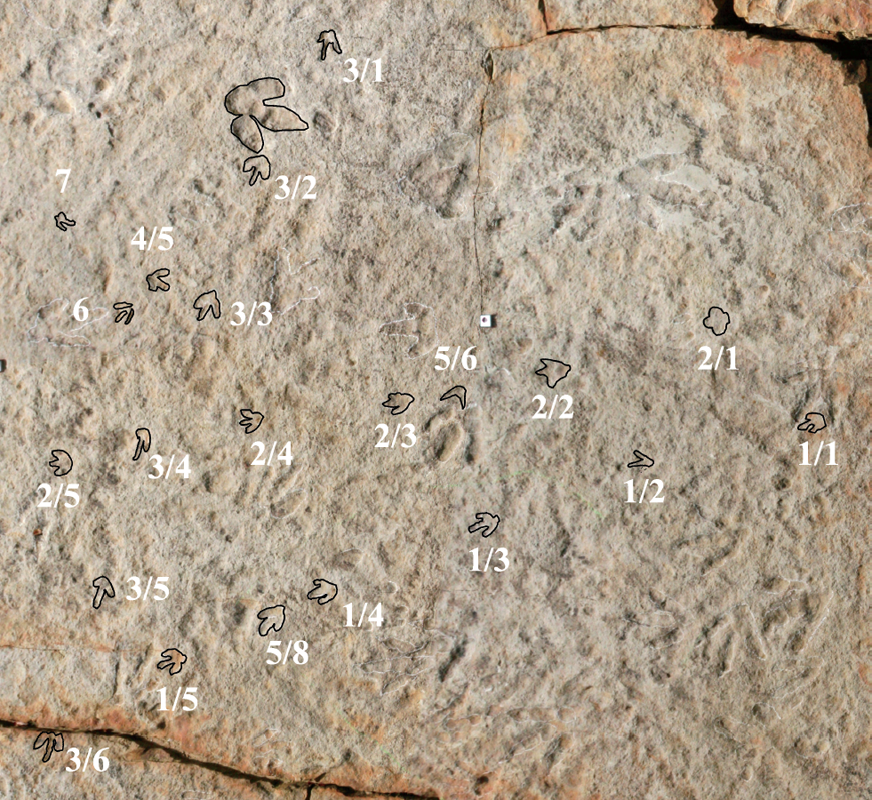
16.3. Close-up of Figure 16.2 with the highest density of possible ornithischian tracks showing strong dinoturbation on the Chicken Yard Tracksite.
MATERIALS AND METHODS
The tracks were measured in the field with a caliper and a goniometer. The measured distances of a track are mainly configured as in former studies (e.g., Thulborn, 1990; Romilio and Salisbury, 2011), but the width of the digits is slightly differently defined due to preservation bias (Fig. 16.1). One parameter is the width at digital mid length (BmII, BmIII, or BmIV for individual digits) and the other is the width at the proximal third or base of individual digits (BbII, BbIII, or BbIV). The hypex distances K and M (Moratalla, Sanz, and Jiménez, 1988; Romilio and Salisbury, 2011) were not measured, because most tracks had no consistent outline between the digits, where the distal endpoints of these distances could be defined. Divarication angles were measured between the central posterior border of the metatarsal imprint and the utmost distal tip of each digit. The ratios of the sample of published tracks were obtained directly from the respective figures in these papers.
The gathered data were exported into Microsoft Excel for bivariate regression analyses of simple values as well as ratios. Complete data sets were also exported into PAST (Palaeontological Statistics, version 1.38; Hammer, Harper, and Ryan, 2001) for conducting principal component analyses (PCA) and discriminant analyses. The latter are automatically combined with the Hotelling’s t-squared test comparing the means of multivariate data sets (Hammer and Harper, 2006). Three-dimensional images of some of the tracks were provided by van der Lubbe, from which the gray-shaded contour images of Figure 16.4 are derived. He used the software PhotoModeler from Eos Systems.
Table 16.1. Measurements obtained from the small ornithischian tracks of the Chicken Yard Tracksite
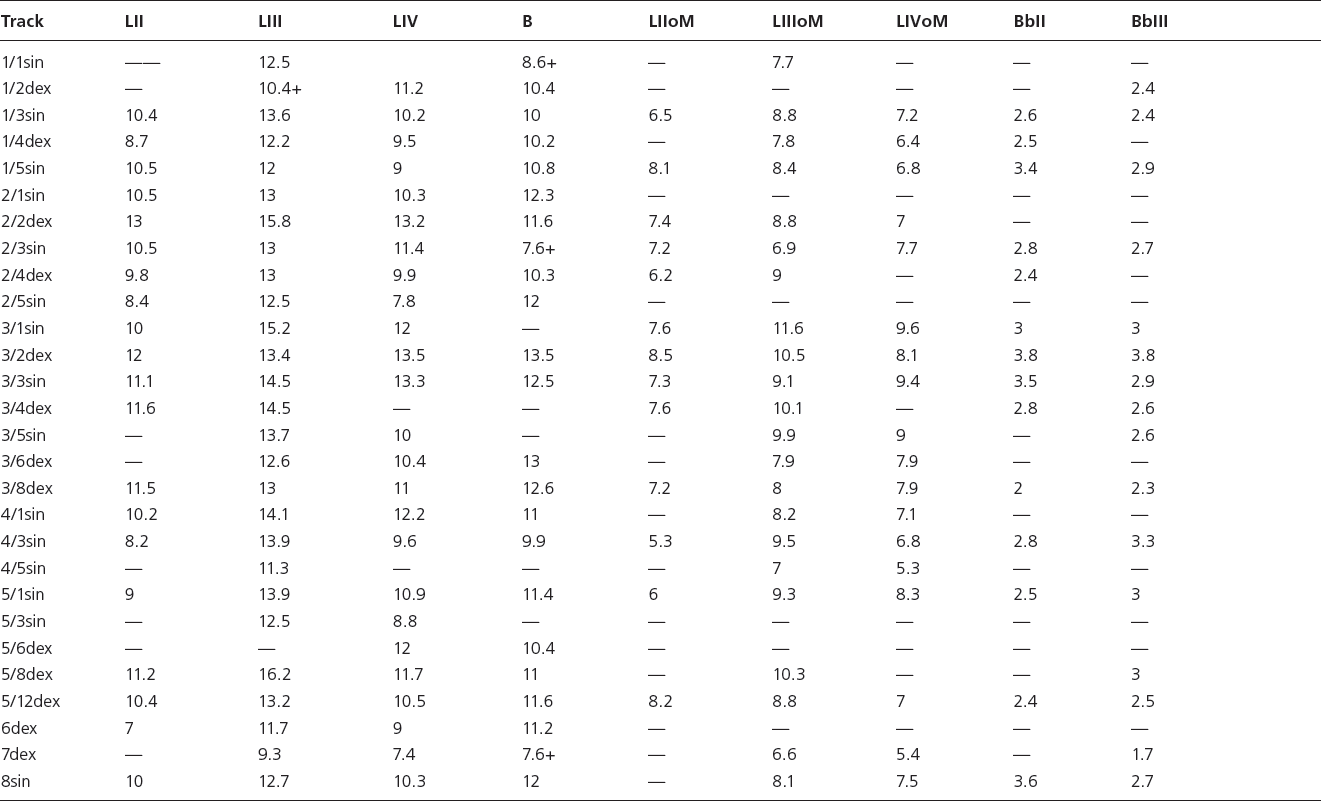
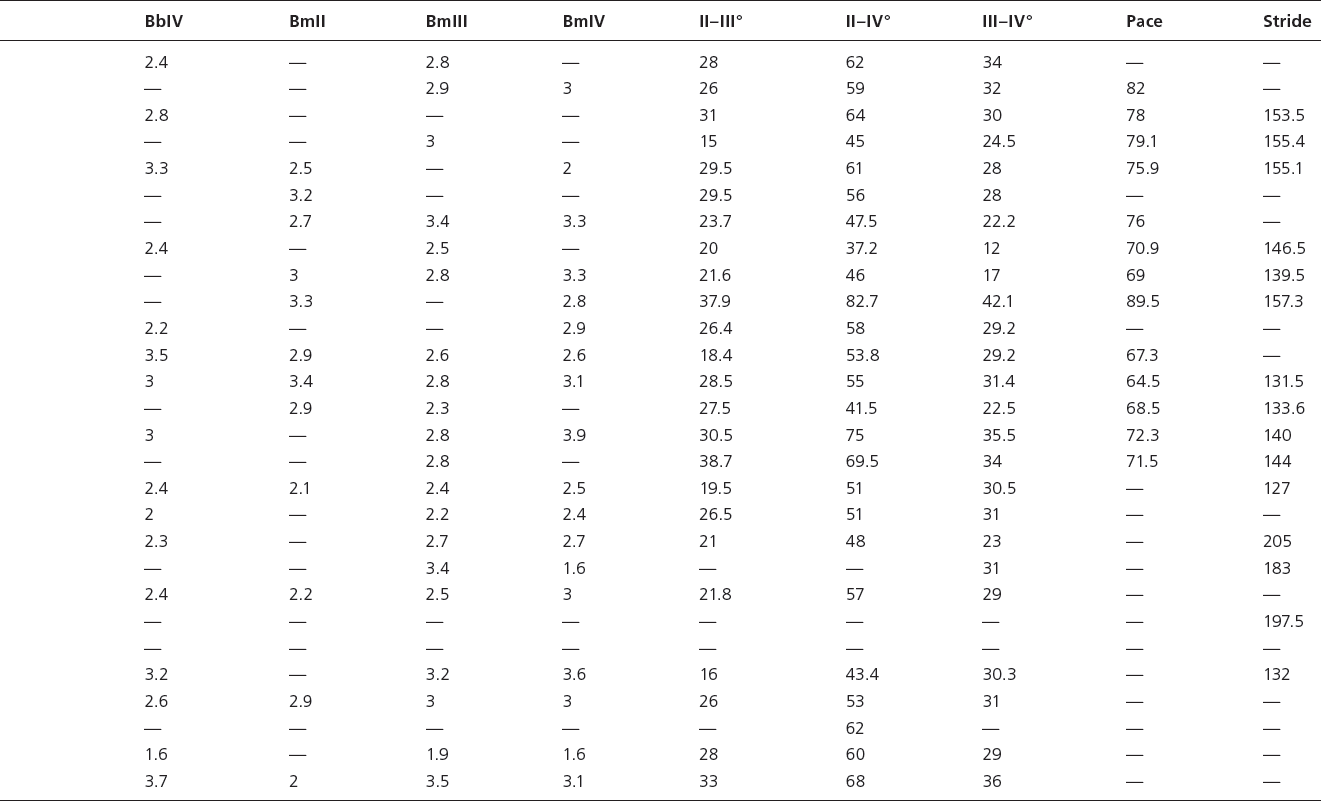
Notes: The track labels are in accordance with Figure 16.2. Values with a plus sign are minimum values due to incompleteness of the respective distance. These are treated as missing values in all quantitative analyses. Abbreviations: LII, length along second digit; LIII, length along third digit, the same as total track length; LIV, length along fourth digit; B, total track width; LIIoM, length of second digit without metatarsal; LIIIoM, length of third digit without metatarsal; LIVoM, length of fourth digit without metatarsal; BbII, width at proximal third or base of second digit; BbIII, width at proximal third or base of third digit; BbIV, width at proximal third or base of fourth digit; BmII, width at mid length of second digit; BmIII, width at mid length of third digit; BmIV, width at mid length of fourth digit; II–III°, divarication angle between digits II and III; III–IV°, divarication angle between digits III and IV; II–IV°, divarication angle between digits II and IV; sin, sinistral; dex, dextral.
RESULTS
General Observations of Tracks and Trackways
Twenty-eight tracks of possible ornithischian affinity were found. Three tracks are isolated and 25 tracks belong to five trackways. All tracks and trackways are located in the central third of the Chicken Yard tracksite, comprising approximately 80 m2, and only trackways 1 and 2 have subparallel directions (Figs. 16.2 and 16.3).
The central area shows a high degree of dinoturbation, so that single tracks within three trackways are missing. There are strong differences in track preservation ranging from shallow but well-imprinted tracks (~1.5 cm), with all three toes clearly visible, to very flat and incomplete tracks, where only one or two toes are recognizable and the track outline is very poorly preserved. These latter tracks were only identified by following and observing along the sequence of the better preserved tracks of a given trackway. With one possible exception, none of the tracks show unambiguous signs of separate claw marks. Pace angulations are generally close to 180°. All measurable distances and angles obtained from the tracks are presented in Table 16.1. A detailed description of individual tracks and trackways can be found in Appendix 16.1.
Analyses of Track Measurements
The goal was to look for quantitative differences between the possible ornithischian tracks and the theropod tracks of the Chicken Yard tracksite, which could then be used to test the previous trackmaker identification hypotheses originally based only on general qualitative morphology.
First, simple bivariate regressions were applied to look for the degree of comparability among tracks and trackways of assumed ornithischian affinity and selected theropod tracks (see Tables 16.1 and 16.2 for measurements) of the Chicken Yard tracksite, respectively. Correlations between variables of the ornithischian tracks were generally poor to negligible. The highest correlations reached only a coefficient R2 of between 0.5 and 0.7 in 10 of 120 regressions, which comprise mostly relationships of length to width or between the lateral divarication angles. In contrast, correlations between variables of the measured theropod tracks reached coefficients between 0.7 and 1 in 53 of 120 regressions. This demonstrates much better comparability among the chosen, better preserved theropod tracks (Fig. 16.6) than among possible ornithischian tracks (Figs 16.4, 16.5).
A PCA of most ornithischian tracks (excluding all tracks with 50% or more missing values) was performed together with the measured theropod tracks to find variables, which are responsible for most of the variance in the data set. The first two principal components (PC) explain only 64% of the variance. Nearly all metric variables are directed along PC1 (48% of variance), which therefore accounts for size differences in the data set. PC2 (17% of variance) is explained by the differences in divarication angles among the tracks. However, no clear separation between the ornithischian tracks and the theropod tracks are observed. Thus, to exclude size as the major cause for variance, a data set based on ratios of variables was also analyzed by PCA (Fig. 16.7). It becomes apparent that at least five PCs are necessary to explain 95% of the variance, mainly represented by variable ratios of lengths versus digit widths, within the data set. The position of several points within the scatter plot is additionally strongly influenced by missing values, and there is still a strong overlap and, thus, no secured separation between possible ornithischian and theropod tracks.
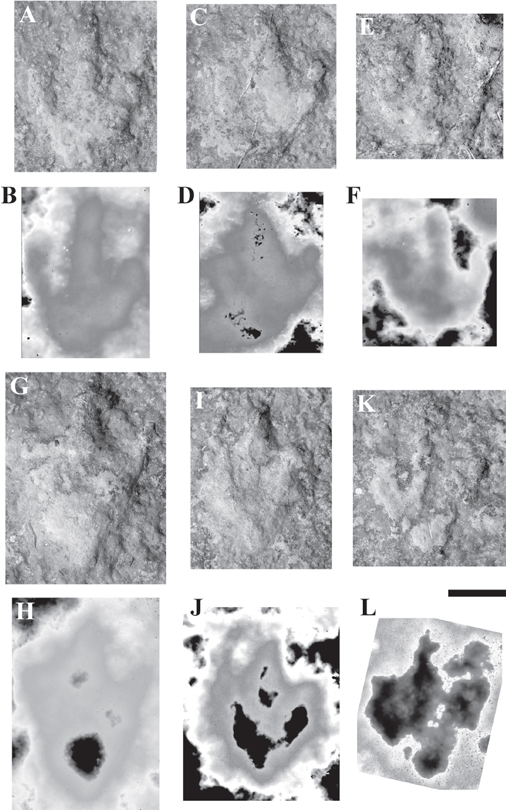
16.4. Images of the small ornithischian tracks, which are at least reasonably well preserved. All images are of the same scale. (A) Track 1/3. (B) Track 1/3, gray-shaded contours. (C) Track 1/4. (D): Track 1/4, gray-shaded contours. (E) Track 1/5. (F) Track 1/5, gray-shaded contours. (G) Track 2/2. (H) Track 2/2, gray-shaded contours. (I) Track 2/3. (J) Track 2/3, gray-shaded contours. (K) Track 2/4. (L) Track 2/4, gray-shaded contours. Scale bar = 5 cm.

16.5. Images of the small ornithischian tracks, which are at least reasonably well preserved. All images are of the same scale. (A) Track 3/1. (B) Track 3/3. (C) Track 3/6. (D) Track 3/8. (E) Track 4/1. (F) Track 5/1. (G) Track 5/8. (H) Track 5/12. (I) Track 6. Scale bar = 5 cm.
Table 16.2. Measurements obtained from the chosen theropod tracks of the Chicken Yard Tracksite


Notes: Values with a plus sign are minimum values due to incompleteness of the respective distance. These are treated as missing values in all quantitative analyses. Abbreviations: Tw, trackway; other abbreviations as in Table 16.1.
In the next step, bivariate regressions of ratios were performed to find indications as to whether the possible ornithischian and theropod tracks of the Chicken Yard tracksite can be distinguished in this way. Only 11 of 87 created combinations showed a detectable separation of the two groups (single outliers can still be involved). These cases were then chosen to test whether clearly identified ornithischian and theropod tracks chosen from the literature (Table 16.3) also plot within the respective areas.
Apart from still-visible restricted overlap and isolated outliers, there are mainly two morphological characters that separate both groups of tracks (Figs. 16.8 and 16.9). First, theropod tracks have generally shorter lateral digits compared to the third digit (strong mesaxony), whereas the ornithischian tracks (including two ichnospecies of Anomoepus) tend to have smaller differences in length between these digits (weaker mesaxony; see Lockley, 2009). Even clearer is the tendency of theropod tracks to have more slender digits compared to length than the ornithischian tracks, especially regarding the ratio of total track length (LIII) relative to width of the third digit at its mid length (BmIII). However, cases of covariance of both track groups are also present (Fig. 16.9), reflecting the highly similar bauplan of their feet. For instance, more slender lateral digits are correlated with a more slender third digit and a relatively longer second digit compared to the third digit means also increased slenderness of the former.
The final test for disparity between the two track groups was the discriminant analysis of the multivariate data set (Fig. 16.10). This was again performed without the tracks, which provided 50% or less of the necessary values, but the published tracks of unambiguous ornithischian and theropod tracks were included. This analysis resulted in a significant (Hotelling’s t-squared with p = .0657) separation of both track groups, where 92.31% of the tracks could be grouped correctly.
DISCUSSION
Traditional Discrimination of the Small Tridactyls of the Chicken Yard Tracksite
Only a minority of the smaller tracks on the Chicken Yard tracksite are of possible ornithischian affinity. They were initially recognized by observation, because they differed in several features from most of the well-recognizable theropod tracks. These comprise the lack of claw marks, blunt ends of the digits, thicker digits with only two digital pads at maximum even in the third and fourth digit, the overall length-width ratio, the close proximity or partial fusion of digital imprints posteriorly, and especially the rear of the track with an often continuous metatarsal imprint and symmetrical posterior portion of the track. In contrast, the metatarsal imprint of typical theropod tracks on the Chicken Yard tracksite is often a kind of posterior extension of the fourth digit resulting in an asymmetrical posterior track shape; the individual digital imprints of a track are in many cases even posteriorly well-separated; the third and fourth digits have often more than two digital pads; less splayed tracks are longer than wide; and claw marks are quite common. These subjective criteria are similar to the features, which have been discussed for decades, as those utilized for potentially discriminating ornithopod from theropod tracks (e.g., Thulborn and Wade, 1984; Moratalla, Sanz, and Jiménez, 1988; Thulborn, 1990; Foster and Lockley, 1995; Lockley, 2009; Belvedere, Mietto, and Ishigaki, 2010; Martin et al., 2011; Romilio and Salisbury, 2011; Castanera et al., 2013; Romilio, Tucker, and Salisbury, 2013).
The main reason for the difficulties in tridactyl track differentiation is the conservative bauplan of the foot skeleton of theropods and many small and/or less-derived ornithischians, including small ornithopods (Thulborn, 1990; Farlow and Lockley, 1993; Farlow and Chapman, 1997; Farlow et al., 2012). Both have the same numbers of phalanges in the weight bearing digits (II = 3, III = 4, IV = 5) and a similar degree of digitigrady due to their mostly longer than wide phalanges. Even the shape of the claws is similar because these are slightly curved and pointed at their tip in many small ornithischians including basal ornithopods and iguanodontians. Exactly this claw morphology can also be observed in some theropods, such as ornithomimosaurs (see Choiniere, Forster, and de Klerk, 2012:fig. 14F). It is therefore not surprising to find a strong graphical overlap of both groups in the bivariate regression and PCA (Figs. 16.7, 16.8, and 16.9; see also Farlow and Chapman, 1997; Farlow et al., 2012) of simple variables and ratios, respectively.
There are some observed features of the possible ornithischian tracks discussed here that do not match the traditional scheme, such as the weak or absent inward rotation of individual tracks, the high pace angulation, or the large pace and stride lengths. The stride distances of the trackways (see Table 16.4 for associated hip heights, relative stride lengths, and speeds) are indeed longer than noted for ornithischian trackways often recorded elsewhere (e.g., compare with Lockley et al., 1998; Azuma et al., 2006), but it has been shown that these calculations and associated measurements can vary. Furthermore, it is unlikely that these dinosaurs moved slowly all the time, so that short steps and strides including pace angulation cannot serve as ornithischian-only track features and are more related to the trackmakers’ gait at the time of track formation (Romilio and Salisbury, 2014). The inward rotation of individual tracks is also not universally applicable to all identified ornithischian trackways (e.g., see Delatorrichnus in de Valais, 2011; sitting traces of Anomoepus in Olsen and Rainforth, 2003), although many do show this feature (e.g., Lockley et al., 1998; Moratalla, Hernan, and Jiménez, 2003; Gierlinski, 2009; Kim et al., 2009; Lockley, McCrea, and Matsukawa, 2009; Li et al., 2011; Castanera et al., 2013; Xing and Lockley, 2014). However, the ichnogenus Siamopodus, identified as made by a theropod due to claw marks and deep hypices, shows inward rotation of individual tracks (Xing, Lockley, et al., 2014), as in some other theropod tracks, so that this feature cannot universally serve as typical for ornithischian tracks as well.
Some other features of the tracks described here, such as the absence of hallux imprints or the stronger mesaxony in some of the tracks, naturally more resemble theropod tracks. These potential flaws in the assignment to ornithischian trackmakers are also contradictable. On the one hand, hallux imprints are found in ornithischians with a rather long hallux (most basal ornithischians, basal marginocephalians, basal ornithopods, and some basal iguanodontids) only preserved in very deep imprints or in sitting/resting traces (e.g., Anomoepus). On the other hand, the degree of mesaxony is also not an unambiguous feature for either ornithischians or theropods, because there are strong indications of convergence between these clades as well as differences within each of the clades (Lockley, 2009). Ontogeny should also be kept in mind, because the length of the digits is negatively allometric in growth (Hübner, 2011), which is also observable in tracks of different sizes within single ichnogenera (Lockley, 2009). There are, for instance, ornithopod tracks known with a comparatively strong mesaxony (Castanera et al., 2013) and theropod tracks with weak mesaxony (Xing, Lockley, et al., 2014).
Overall, the described small tracks of the Chicken Yard tracksite are qualitatively different to the often much easier identifiable theropod tracks, so that different trackmakers are very likely. The best alternative are small ornithischians, because of their foot morphology and because body fossils are well known in Europe around this time interval.

16.6. Images of some of the theropod tracks from the Chicken Yard Tracksite, which were measured for this study (see Table 16.2 for measurements). (A) Track TW1/2sin. (B) T1dex-gracile. (C) T2sin-claws. (D) T3sin-pads. (E) T9sin. (F) T10sin. Scale bars = 5 cm. Abbreviations as in Figure 16.1.
Preservation Complicates Matters
The assignment of some tracks to either of the two tridactyl groups is qualitatively equivocal. The poor preservation of several ornithischian tracks naturally obscures many features, but even better preserved tracks within a trackway show remarkable morphological variability including the shape of the metatarsal imprint, the degree of separation of the digit imprints, the degree of mesaxony, the relative widths of the digits as well as of the whole track, either blunt or acute distal ends of the digits, and the interdigital angles. Thus, the tracks could not unambiguously be assigned to a single known ichnospecies, and it is also not advisable to name a new ichnospecies. The combination of poor preservation and strong variability is thus the main reason for the poor correlation of measured distances and angles among the ornithischian tracks. The theropod tracks measured from the Chicken Yard tracksite show much higher correlation because only well-preserved examples were chosen for this study.
Richter and Böhme (2016) have demonstrated that the Chicken Yard tracksite is in most parts heavily altered by dinoturbation representing an unknown number of trampling events. The ornithischian tracks are definitely not the last of these events, because some of the tracks are partially overprinted or at least altered in shape by tracks made later close by. It is also clear that the potential trackmakers were not moving together over this area at exactly the same time, because the trackways are not parallel to each other nor do they show other signs of gregarious behavior (Cotton, Cotton, and Hunt, 1998; Lockley et al., 1998; Lockley and Matsukawa, 1999). However, as is demonstrated by trackway 3, intense trampling has not led to an evenly consolidated surface. The first track (3/1) was made on a slippery surface because the third digit slipped sideways before making the final imprint, which probably also included the claw (extended digit length) and was narrowed after withdrawing of the digit by the collapsing right wall (Fig. 16.5A). Three other flat tracks (3/2, 3/5, 3/6) (Fig. 16.5C) were made on firm, well-consolidated ground with lower water content. The third track (3/3) has well-defined steeper track walls (Fig. 16.5B), indicating firm but more moist ground. Finally, the last track (3/8) has shallowly inclined track walls and no details preserved on the very smooth track bottom (Fig. 16.5D), which might indicate that the sandy substrate was highly saturated at the time of track formation (Milàn, 2006) or that this spot was covered by shallow standing water, such as a puddle. Dry conditions are unlikely due to the absence of contouring fractures (Jackson, Whyte, and Romano, 2009). Interestingly, the nearby track 5/12 shows exactly the same preservational mode (Fig.e 16.5H). Saturated substrate at the time of track formation is also evident in track 4/1, where the track wall of the second digit has partially collapsed (Manning, 2004) (Fig. 16.5E). Overgrowth by microbial mats (Marty, Strasser, and Meyer, 2009), although difficult to prove directly (Richter and Böhme, 2016), had also taken place in variable intensity in several of the ornithischian tracks. Some even show strong overgrowth intensity leading to the formation of internal overtracks (compare Figs. 16.4K and 16.5E with Marty, Strasser, and Meyer, 2009:fig. 8). All these influences contributed to the strong preservational impact on the morphology of the small ornithischian tracks, which can therefore be classified as modified true tracks or internal overtracks (sensu Marty, Strasser, and Meyer, 2009).
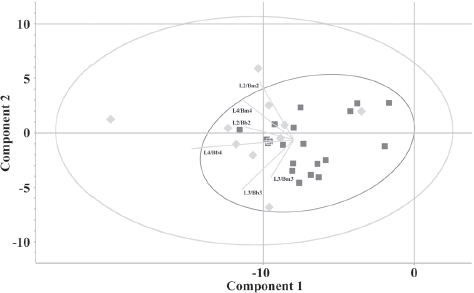
16.7. Plot of the first versus second principal component of variable ratios. Gray diamonds and respective 95% ellipse represent the Chicken Yard Tracksite theropod tracks. Black squares and respective small 95% ellipse represent the small ornithischian tracks. The lines in the center (biplot graphs) show which ratios best describe the first and/or second principal component (PC). Although together these two PCs explain only 57% of the variation, the biplots of the third through fifth PCs consist of the same ratios with only slightly different relative lengths. Therefore, 95% of the variation (represented by five PCs) is explained by the plotted ratios. Abbreviations as in Figure 16.1.
The Solution Is in Sight
As there are no associated manus imprints visible, as the only unambiguous evidence for small ornithischians (e.g., Thulborn, 1990; Olsen and Rainforth, 2003; Stanford, Weems, and Lockley, 2004; Castanera et al., 2013), other less obvious features, which may be present despite the variable track preservation, had to be found in this study. Such features are found here and comprise mainly the average degree of mesaxony (Lockley, 2009) and the length-width ratio of the single digits. Thus, many theropod track types show a stronger mesaxony and also have more slender digits than the average ornithischian track does. These features were formerly used for discriminating the two groups (e.g., Moratalla, Sanz, and Jiménez, 1988; Thulborn, 1990; Gierlinski, 2009; Kim et al., 2009; Li et al., 2012; Castanera et al., 2013) and their significance can now be supported, although the strong overlap in the plots as well as exceptional ichnogenera from elsewhere (e.g., Corpulentapus, Li et al., 2011; Lockley et al., 2015) have to be kept in mind. Divarication angles for instance are not at all usable for this purpose, as was already pointed out by Milàn (2006). Other, less clearly identifiable features may also contribute to the surprisingly distinct discrimination of the two track types. However, the plotting of some published tracks of well-accepted ornithischian affinity (e.g., Dinehichnus; see Figs. 16.8 and 16.9) within the scatter plot of the theropod tracks additionally demonstrates the anatomical similarities between ornithischian and theropod feet. Much more comprehensive data sets should be created in future studies incorporating all well-defined and supported ichnospecies of ornithischian affinity as well as key ichnotaxa of theropods of all Mesozoic time intervals, respectively. By building on and by combining the results of Moratalla, Sanz, and Jiménez (1988) with the current study, it should then be possible to clarify, more definitively, which unambiguous features are most informative for distinguishing between well-preserved ornithischian and theropod tracks of all sizes. Further experimental studies on the relationship between gait and track formation would also be eligible to clarify for instance, whether and how gait influences important features such as rotation of individual tracks.
Table 16.3. Ratios of measured distances of some published tracks with generally accepted track affinity, including theropods, ornithopods, and small ornithischians
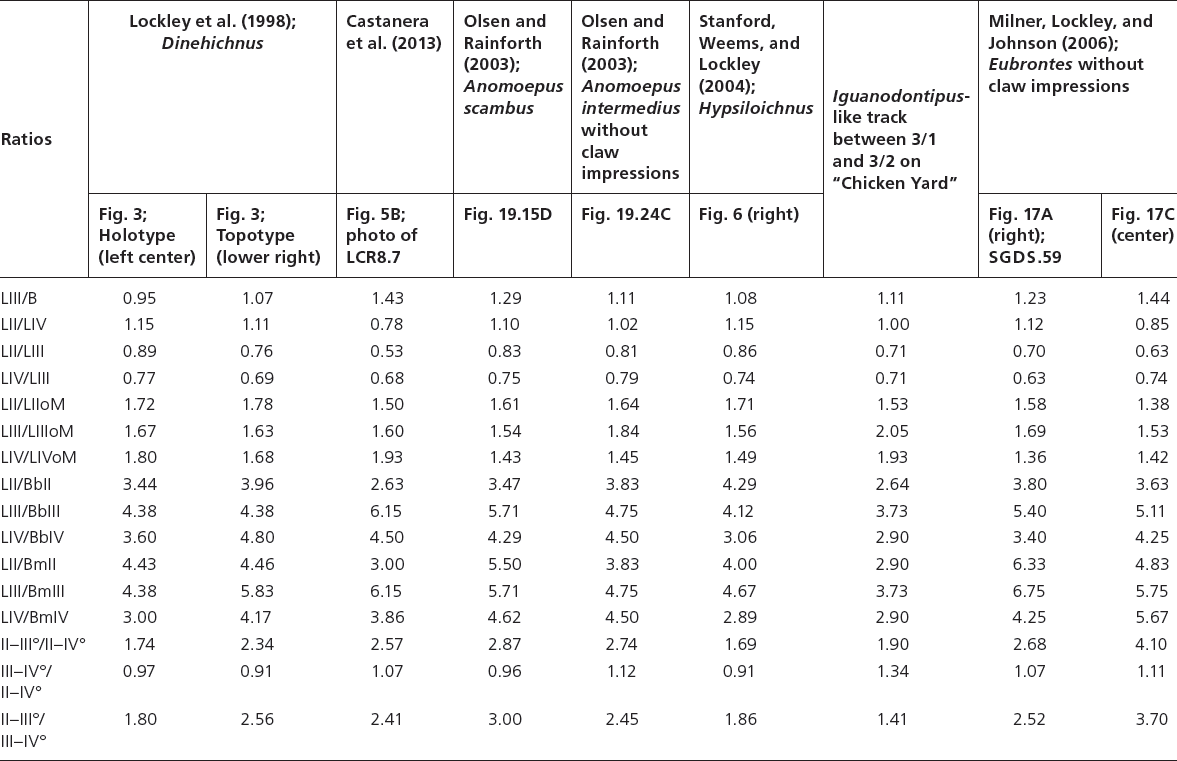
Note: LCR, Las Cerradicas tracksite; SGDS, St. George Dinosaur Discovery Site; other abbreviations as in Table 16.1
Ornithischian Trackmaker Candidates
The true biodiversity of small-bodied species is often much larger than indicated by both the fossil body and track record (Brown et al., 2013). Despite this, up to four different groups of ornithischians are represented by body fossils in close spatial and/or temporal proximity to the Chicken Yard tracksite, so that these at least should to be taken into account as possible small trackmakers. These groups comprise heterodontosaurids, basal ornithopods, dryosaurid ornithopods, and basal marginocephalians.
The first candidate is Echinodon becklesii from the Berriasian Purbeck Limestone Formation of southern England, which is only known from skull fragments and teeth (Norman and Barrett, 2002; Galton, 2012). It is commonly classified as a basal heterodontosaurid (Norman and Barrett, 2002; Butler et al., 2010; Butler et al., 2012), although Pol, Rauhut, and Becerra (2011) found it to be placed as a basal ornithischian. The only related taxa with preserved feet are Heterodontosaurus tucki (Santa Luca, 1980) and Tianyulong confuciusi (Zheng et al., 2009), which have three well-developed functional toes (II to VI) and a reduced first digit, respectively (Fig. 16.11A). Although this pedal anatomy would fit nicely to the small ornithischian tracks of the Chicken Yard tracksite, the diminutive size of all known late heterodontosaurids of significantly less than 1 m in total body length (Zheng et al., 2009; Butler et al., 2010, 2012; Galton, 2012) makes heterodontosaurids less likely trackmaker candidates.
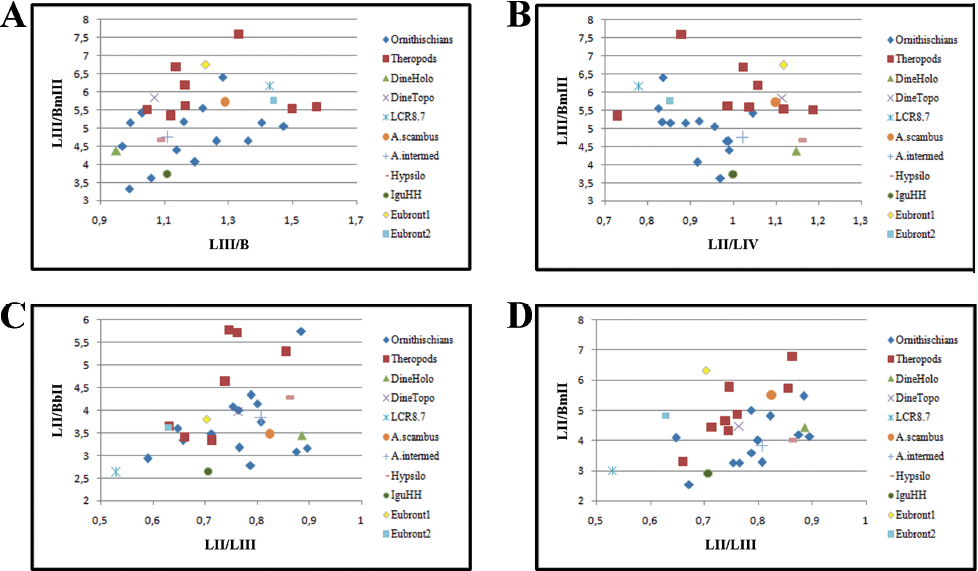
16.8. Bivariate plots of ratios of tracks of small ornithischians (blue diamonds) and theropods (red squares) from the Chicken Yard Tracksite. Note simple variance (e.g., top right) of track ratios. Plots of published tracks as well as of the large Iguanodontipus-like track from the Chicken Yard Tracksite (see Table 16.3 for detailed references) are added subsequently. Abbreviations: A. intermed, Anomoepus intermedius; A. scambus, Anomoepus scambus; DineHolo, Holotype track of Dinehichnus socialis; DineTopo, Topotype of the latter; Eubront1, Eubrontes 1; Eubront 2, Eubrontes 2; Hypsilo, Hypsiloichnus marylandicus; IguHH, Iguanodontipus-like track from the Chicken Yard Tracksite; LCR8.7, Respective ornithopod track from the Las Cerradicas tracksite; other abbreviations as in Figure 16.1.
More likely in terms of body size are basal ornithopods similar to the Barremian taxa Hypsilophodon foxii (United Kingdom; Galton, 1974, 2009, 2012) and Gideonmantellia amosanjuanae (Spain; Ruiz-Omeñaca et al., 2012). There are no body fossil records known from the Berriasian of Europe, but the morphology of the tracks of the Chicken Yard tracksite fit nicely to the pedes of basal ornithopods (Galton, 1974) with only three functional digits (Fig. 16.11B). The first digit is still relatively long, but the tracks are not deep enough to produce an imprint, and the assumed fast gait implies the imprint of the hallux unlikely. The North American ichnotaxon Hypsiloichnus was also referred to a basal ornithopod similar to Hypsilophodon or Zephyrosaurus schaffi (Stanford, Weems, and Lockley, 2004), although the tetradactyl pes imprints do not look like deep tracks sensu Marty, Strasser, and Meyer (2009). However, a close relative of Zephyrosaurus, Orodromeus makelai (Scheetz, 1999), has a slightly longer first digit than Hypsilophodon does, the fourth finger of the manus is also relatively longer, and the arms were stoutly built with possibly hyperextendable fingers as a sign for at least facultative quadrupedality (Scheetz, pers. comm., April 2013). It is therefore indeed possible that Hypsiloichnus was produced by a yet unknown basal ornithopod, although the known taxa with preserved hands and feet (Gilmore, 1915; Galton, 1974; Scheetz, 1999) all have slightly differing proportions with relatively shorter fourth fingers of the manus and first digits of the pedes. Other ornithischians, especially basal neoceratopsians, also have much smaller forelimbs than hind limbs as well as manus and pes morphologies very similar to basal ornithopods (Hailu and Dodson, 2004). They were even present in North America during the late Early Cretaceous (Chinnery-Allgeier and Kirkland, 2010), so that they should equally be considered as possible trackmakers of Hypsiloichnus.
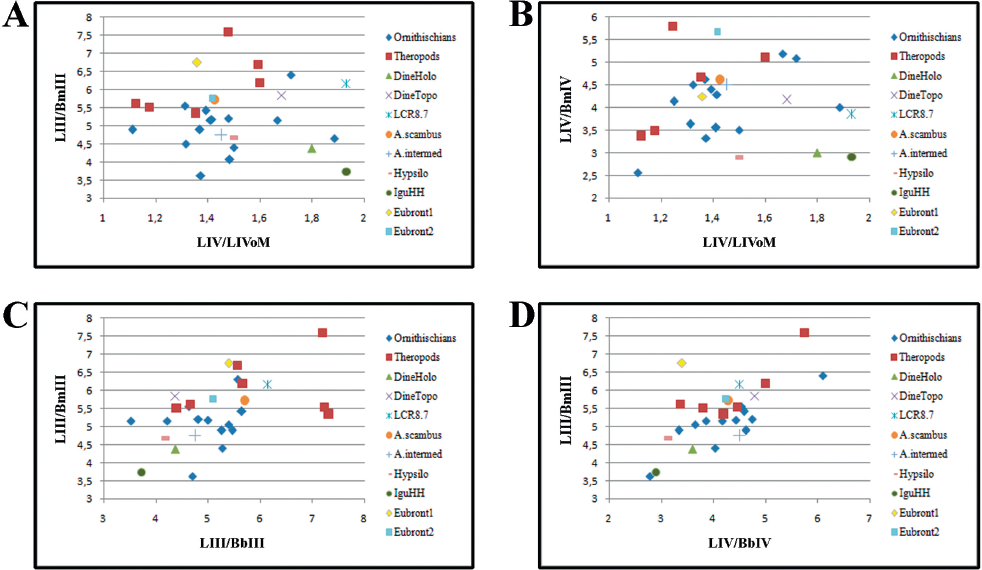
16.9. Bivariate plots of ratios of tracks of small ornithischians (blue diamonds) and theropods (red squares) from the Chicken Yard Tracksite. Note simple covariance (e.g., bottom right) of track ratios. Plots of published tracks as well as of the large Iguanodontipus-like track from the Chicken Yard Tracksite (see Table 16.3 for detailed references) are added subsequently. Abbreviations as in Figures 16.1 and 16.8.
European taxa of the third group of potential trackmakers, dryosaurid ornithopods, are known from the Middle Jurassic of England (Callovosaurus leedsi; Ruiz-Omeñaca, Pereda Suberbiola, and Galton, 2007), the Upper Jurassic of Portugal (Eousdryosaurus nanohallucis; Escaso et al., 2014), and the Early Cretaceous of England (Valdosaurus canaliculatus; e.g., Galton, 2009; Barrett et al., 2011). The English specimens of Valdosaurus are from the Valanginian and Barremian and therefore of younger age than the Chicken Yard tracksite, whereas the Berriasian specimens from Romania formerly assigned to Valdosaurus or Dryosauridae indet. (Posmoşanu, 2003) are now all considered to be Euornithopoda indet. (Galton, 2009). Nevertheless, the Chicken Yard tracksite is bracketed in time by the secured dryosaurid occurrences, so that they were most likely also present here. Dryosaurs have typical tridactyl feet with a strongly reduced first digit without nonungual phalanges (Norman, 2004; Escaso et al., 2014) (Fig. 16.11C). The unguals are more hoof-like than in basal ornithopods, but they still taper acutely distally (Galton, 1981). Dryosaurs are further treated as obligate bipeds (Hübner, 2011; contra. Heinrich, Ruff, and Weishampel, 1993) better resembling with their highly cursorial pes morphology the basal ornithopods such as Hypsilophodon than most of the less-derived basal iguanodontians (Norman, 2004) so that their tracks would be hardly distinguishable from the former. Dinehichnus socialis is the only ichnotaxon, which is currently tentatively assigned to dryosaurs (Lockley et al., 1998), although a camptosaur affinity is also likely (Gierlinski and Sabath, 2008). It is known from the Upper Jurassic of western North America, Portugal, and Poland (Lockley et al., 1998; Gierlinski, Niedzwiedzki, and Nowacki, 2009) and probably from the Berriasian of Spain and Germany (Hornung and Reich, 2012; Castanera et al., 2013). The average size of the tracks is slightly larger than the small tracks from the Chicken Yard tracksite and only tracks 1/3 and 3/6 look roughly similar to Dinehichnus with an indicated rounded and separated metatarsal imprint (Figs. 16.4A and 16.5C). Despite these exceptions, the tracks cannot securely be assigned to Dinehichnus due to their often continuous posterior metatarsal border and less well-separated and more slender digit imprints. However, small dryosaurs are still potential trackmakers of the ornithischian tracks of the Chicken Yard tracksite, because it is not clear yet whether all dryosaurus are bound to produce Dinehichnus track types in every possible substrate.
The associated oval manus imprints of the Las Cerradicas locality may also indicate a basal ankylopollexian ornithopod as their potential trackmaker (Castanera et al., 2013), because the reduced manus of dryosaurids is unlikely to produce such an oval-shaped imprint. In contrast, basal ankylopollexians had still relatively slender feet but the manus already showed significant adaptations toward weight-bearing and quadruped locomotion (Carpenter and Wilson, 2008). Members of the latter clade were definitely present in Europe during the Late Jurassic and Early Cretaceous (Galton and Powell, 1980; Norman and Barrett, 2002) and may well be the more probable trackmaker at the Las Cerradicas tracksite.
The possible smoking gun for the identity of the small trackmakers on the Chicken Yard tracksite might be the partial skeleton of Stenopelix valdensis (Richter et al., 2012). It was found in a now historical quarry of the Harrl Hill near Bückeburg in the same formation (Obernkirchen Sandstone) as the Chicken Yard tracksite (Hornung, Böhme, and Reich, 2012; Richter et al., 2012). Its phylogenetic position is close to the base of Marginocephalia (Butler and Sullivan, 2009) or even at the base of Ceratopsia (Butler et al., 2011). Stenopelix possesses a slender pes with three functional digits with pointed but only weakly recurved unguals, whereas the first digit is reduced in length (Fig. 16.11D). This is very similar to the configuration seen in basal ornithopods, and it would therefore have been able to produce similar tracks. The pes morphology, the body size, and the secured occurrence in the Obernkirchen Sandstone make this small dinosaur a good candidate as producer of the small ornithischian tracks on the Chicken Yard tracksite, although the three other options are also likely.
CONCLUSIONS
The twenty-eight potential ornithischian tracks identified on the Chicken Yard tracksite comprise five trackways and three isolated tracks. They differ from typical theropod tracks of this site mainly by the observations of having a more symmetrical outline, an often consistent posterior metatarsal border and the absence of claw marks. Other traditionally used discriminating features are more ambiguous, especially due to the strong and variable preservational influence on the track morphology. The tracks are in general preserved as modified true tracks or internal overtracks. Bivariate regressions analyses and PCA yielded no clear results, but a minority of bivariate regressions of ratios of distances as well as a multivariate discriminant analysis resulted in a distinct separation of the two track types. Subsequently included examples of well-defined published ichnospecies fitted well into this scheme. Theropod tracks can accordingly be distinguished from ornithischian tracks by a larger length difference between the third and the lateral digits (mesaxony) and by generally more slender digits, but the morphological variation within the latter hampers a sharp differentiation. These results are preliminary due to the comparatively small data set, but in combination with similar studies on large ornithopod tracks and a more comprehensive data set, they may be a good starting point for future studies finally leading to secured discriminating features for theropod and ornithischian tridactyl tracks. The small ornithischian tracks of the Chicken Yard tracksite may have been produced either by heterodontosaurids, basal ornithopods, dryosaurid ornithopods, and/or basal marginocephalians. The latter taxon is represented by a partial skeleton of Stenopelix found nearby and in the same formation, which makes marginocephalian ornithischians currently a plausible trackmaker.
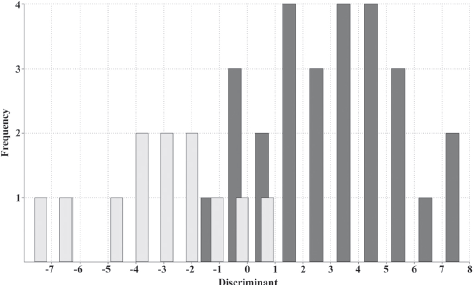
16.10. Graphical result of the discriminant analysis of all ratios of ornithischian and theropod tracks, except tracks with 50% or more missing values, and also including the chosen published tracks (see Table 16.3 for identity). Light gray indicates theropod tracks; dark gray indicates ornithischian tracks.
ACKNOWLEDGMENTS
I would like to thank Annette Richter for her unmatched support. I also thank Annina Böhme for her helpful suggestions. I especially thank Torsten van der Lubbe, who introduced me to the Chicken Yard tracksite and the basics of paleoichnology. I also thank Jahn Hornung, Martin Lockley, and Brent Breithaupt for their very helpful comments on this manuscript. Finally, I am very grateful to my wife for her patience and encouragement.
Table 16.4. The average total track length (Ø LIII) of each of the five ornithischian trackways and the average stride lengths were used to calculate hip heights and speed of the trackmaker

Notes: The conversion factor 4 was taken from Alexander (1976) and the conversion factor 4.6 was taken from Thulborn (1990) for small biped dinosaurs. The relative stride lengths (SL/h) show that the trackmakers have all been trotting (>2.0) or running (>2.9).
APPENDIX 16.1: DESCRIPTION OF THE POTENTIAL SMALL ORNITHISCHIAN TRACKS OF THE CHICKEN YARD TRACKSITE
Trackway 1 consists of five consecutive tracks. Overall dimensions of individual tracks as well as pace and stride are almost identical (Table 16.1). The first track (1/1) is partially overprinted by larger tracks, so that the distal ends of both lateral digits are missing. A low displacement rim is present around the third digit and the slightly asymmetrical and wide metatarsal imprint, respectively. The distal third of the third digit imprint is the deepest part of the track. The second track (1/2) is of very poor preservation, because it is disturbed by a large track on its left side, it is very shallow, and its outline is very weakly visible. According to its position, 1/2 is a right track and the only preserved outlines belong to the distal ends of the weakly separated third and fourth digits. The third track (1/3) is reasonably well preserved in comparison to the former two tracks, because all three digits are visible and contain two individual pad imprints each (Figs. 16.4A, 16.4B). Digits II and IV are of roughly the same length and divarication angle. The second digit is distinctly separated from the metatarsal imprint, whereas the fourth digit merges to a slightly concave outline with the latter. The fourth track (1/4) is slightly disturbed by another track on its left side but it is otherwise of good preservation (Figs. 16.4C, 16.4D). The relative lengths of the digits, the divarication angles, and the total length/width ratio (slightly longer than wide; see Table 16.1) are similar to the third track. Differences consist of the much larger width of the third digit imprint and the weak appearance of the fourth digit. The fifth track (1/5) is of equal quality to those of the third and fourth digits and all relevant features are also comparable (Figs. 16.4E, 16.4F). One difference is the posteriorly acute metatarsal imprint.
Trackway 2 consists of five consecutive tracks that are of generally poorer preservation compared to trackway 1. Overall dimensions as well as pace and stride are also slightly more variable (Table 16.1). The first track (2/1) is only recognizable by its three-toed outline. No other internal details are preserved. The anterior separation of the digits is very short and the third digit is thinner than the lateral digits are. Track 2/1 is nearly as wide as long and the lateral digits are almost symmetrical in length and divarication angle. The metatarsal imprint of the second track (2/2) is probably overprinted by a partial other track (no visible outline) because it is deeper and well separated by an internal ridge from the digit imprints. The overall length of the track was still measurable by extrapolating the well-visible course of the lateral outline. The lateral digits are again similar in length and divarication angle (Figs. 16.4G, 16.4H). The imprint of the fourth digit is distinctly tapering, although a separate claw mark is absent. The outline of the other digits is blurred and irregular. The third track (2/3) looks more slender than the other tracks of trackway 2 (Figs. 16.4I, 16.4J). This is in part caused by remaining sediment infill at the rear of the fourth digit imprint and by the smaller divarication angles (Table 16.1). The digit imprints are otherwise well separated from each other by smooth, transitional swellings. The fourth digit is the only imprint, which is fused with the acute but rounded metatarsal imprint. The fourth track (2/4) is similar in symmetry and divarication angles to the former track, but it is generally of inferior preservation (Figs. 16.4K, 16.4L). It is shallower and the outline is more irregular than that of track 2/3, but the main features (long fourth digit united with slender but rounded metatarsal imprint, and second and third digit imprints well separated) are still recognizable. The fifth track (2/5) is even less well preserved because of its shallowness and the very weak outlines of the third digit and of the metatarsal imprint. The best preserved parts are the imprints of the lateral digits, which are of similar length and divarication angle. The latter is significantly wider than in the other tracks of trackway 2 (Table 16.1).
Trackway 3 consists of seven tracks (3/1–3/8), in which the first six tracks are in succession and one track is missing between the sixth and eighth tracks. Overall dimensions and pace are again roughly similar between the individual tracks. The first track (3/1) has well-separated digital imprints with the second digit slightly shorter than the fourth one. The former shows in addition a bulgy proximal portion, whereas the distal part is very slender (Fig. 16.5A). The third digit is unusually long in comparison, but the left track wall is much less inclined than the right wall, which is almost perpendicular to the ground. The divarication angles of both sides are comparable. The deepest parts are within the second and third digital imprint, whereas the shallower fourth digit and the metatarsal imprint are generally less well preserved. The second track (3/2) is slightly rotated outward from the mid-line and overall weakly imprinted. The second digit is only sparsely preserved but still visible. The divarication angle to the third digit is much smaller than the one between the latter and the fourth digit. The third track (3/3) is the best preserved within trackway 3 (Fig. 16.5B). All digits left imprints with clear outlines. The third digit is well separated from the others by a distinct rim. The second digit is divided in two pads. As in the other tracks, the second digit is also closer to the third digit than to the more spread-out fourth digit. The metatarsal imprint is posteriorly extended and acute. The fourth track (3/4) is less well preserved, because the fourth digit is partially overprinted by another large track. The other features are similar to the former tracks with a slender third digit, which is separated by a weak displacement rim, and an acute but rounded metatarsal imprint. The second digit and metatarsal imprint of the fifth track (3/5) are also very shallowly imprinted with the outline almost absent. The imprints of the third and fourth digits are well visible, suggesting no significant deviations from the usual features in this trackway. The sixth track (3/6) is also difficult to recognize due to its shallow impression and an open fissure grazing its almost circular metatarsal imprint (Fig. 16.5C). The relatively well-preserved imprint of the third digit is divided in two digital pads. The fourth digit reaches as far distally as the mid length of the proximal pad of the third digit. The presence of the second digit is only assumable. The last observable track (3/8) is also a right one because the seventh track is not preserved. Its metatarsus is overprinted, but the three digits are well visible (Fig. 16.4D). The length of the lateral digits is similar, but the fourth digit is wider divaricated than is the second digit as in some other tracks of this trackway. Two pads are present in the imprints of the third and fourth digits, respectively. The distal ends of all three digits are blunt.
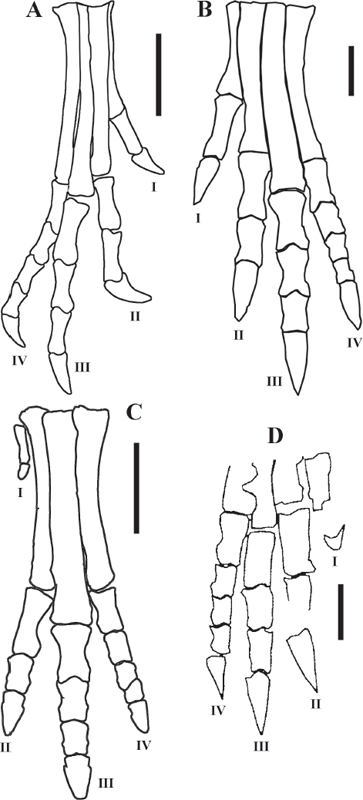
16.11. Sketches of foot skeletons representing four ornithischian clades, which are considered as possible trackmakers of the respective small tracks on the Chicken Yard Tracksite. (A) Heterodontosaurus tucki, scale bar = 3 cm (modified from Sereno, 2012:fig. 71B). (B) Hypsilophodon foxii, scale bar = 2 cm (modified from Galton, 2009:fig. 4L). (C) Eousdryosaurus nanohallucis, scale bar = 5 cm (modified from Escaso et al., 2014:fig. 6). (D) Stenopelix valdensis, scale bar = 2 cm (modified from Butler and Sullivan, 2009:fig. 6).
Trackway 4 consists of three left tracks with all tracks of the right side missing. Their affiliation to the trackway is further evident by the shared orientation, size, and comparable stride lengths (Table 16.1, Fig. 16.2). However, the preservation is rather poor. The first track (4/1) is the best preserved with imprints of all three digits and the metatarsus (Fig. 16.5E). The latter is rounded and slightly acute and separated from the third and second digits by low elevations. The imprints of the digits are deepest in the distal half, respectively. The lateral track wall of the second digit is collapsed. All digits are also wider distally than proximally. The third and fourth digits taper distally, but a separate claw mark is absent. The second track (4/3) has a poorly defined outline showing all three digits with different lengths. The second digit is the shortest and the third by far the longest. The deepest parts are again the distal portions of the digits, but the interior of the track is generally more irregular in depth. The shape of the metatarsal imprint and the distal ends of the digits are similar to the first track. The third track (4/5) preserves only the imprints of the third and fourth digits, whereas the second digit is only weakly indicated and flat.
Trackway 5 consists of five tracks of different preservational conditions ranging from reasonably good to poor preservation. None of the tracks are consecutive, with one to three tracks missing in between, so that their affiliation to a single trackway is treated as tentative. However, the shared direction is conspicuous (Fig. 16.2) and the similarity in morphology and size between the individual tracks is striking. The first track (5/1) is reasonably well preserved with imprints of all three digits and of the metatarsus (Fig. 16.5F). There is even a crescent-shaped imprint visible in front of the second digit, which may represent a blunt claw mark. The fourth digit is widely separated from the third digit, whereas the second digit is only separated from the latter at its distal tip, forming a merged large imprint. The posterior outline of the metatarsal imprint is wide. The second track (5/3) is very shallowly imprinted but its outline is very similar to the first track regarding the asymmetric divarication angles of the lateral digits and the length ratio between the third and fourth digits. It is only slightly smaller in absolute dimensions. The third (5/6) is a right track located distally relative to two missing tracks. It is poorly preserved because most of it is overprinted by a large theropod track anteriorly. Thus, only the posterior outline comprising the external track walls of the lateral digits and the metatarsus are still present (Fig. 16.2). The fourth track (5/8) is better preserved with three recognizable digits, in which the fourth digit is again more widely separated from the third digit than the second one (Fig. 16.5G). The latter is also more shallowly imprinted and more slender than the rest. The comparatively longer third digit distinguishes this track from the other ones of this trackway. The last track (5/12), a left one, skips even three missing tracks. It is remarkably similar to most of the other tracks regarding the asymmetrical divarication angles, the general outline, and the proportions (Fig. 16.5H). The three digits and the metatarsus are all preserved and well separated from each other. The lateral digits are of the same length and the distal ends of the digits as well as the metatarsal imprint are rounded.
The following tracks are isolated finds. Track 6 is a shallow imprint with three digits preserved (Fig. 16.5I). The third and fourth digits are well separated from each other. All digits are slender and the lateral digits are roughly symmetrical in length and divarication angle. The metatarsal imprint is very shallow, small, and slightly acute posteriorly. Track 7 has an incomplete second digit but the remaining parts are preserved. The track has a shallow metatarsal imprint, whereas the third and fourth digits are slightly deeper imprinted. The metatarsal imprint is acute and posteriorly slightly offset, the fourth digit is very slender, and the divarication angle is comparable to the other described tracks (Table 16.1). Track 7 is only slightly longer than wide. Track 8 has very shallow lateral digits and metatarsal imprint with very weakly preserved outlines, respectively. The third digit is slender, well separated from the lateral digits, and distally with the deepest part of the track. The track is symmetrical and has a consistent posterior metatarsal border.
REFERENCES
Alexander, R. M. 1976. Estimates of the speed of dinosaurs. Nature 261: 129–130.
Azuma, Y., R. Li, P. J. Currie, Z. Dong, M. Shibata, and J. Lu. 2006. Dinosaur footprints from the Lower Cretaceous of Inner Mongolia, China. Memoir of the Fukui Prefectural Dinosaur Museum 5: 1–14.
Barrett, P. M., R. J. Butler, R. J. Twitchett, and S. Hutt. 2011. New material of Valdosaurus canaliculatus (Ornithischia: Ornithopoda) from the Lower Cretaceous of southern England. Special Papers in Palaeontology 86: 131–163.
Belvedere, M., P. Mietto, and S. Ishigaki. 2010. A Late Jurassic diverse ichnocoenosis from the siliciclastic Iouaridène Formation (Central High Atlas, Morocco). Geological Quarterly 54: 367–380.
Brown, C. M., D. C. Evans, N. E. Campione, L. J. O’Brien, and D. A. Eberth. 2013. Evidence for taphonomic size bias in the Dinosaur Park Formation (Campanian, Alberta), a model Mesozoic terrestrial alluvial-paralic system. Palaeogeography, Palaeoclimatology, Palaeoecology 372: 108–122.
Butler, R. J., and R. M. Sullivan. 2009. The phylogenetic position of the ornithischian dinosaur Stenopelix valdensis from the Lower Cretaceous of Germany and the early fossil record of Pachycephalosauria. Acta Palaeontologica Polonica 54(1): 21–34.
Butler, R. J., L. Jin, J. Chen, and P. Godefroit. 2011. The postcranial osteology and phylogenetic position of the small ornithischian dinosaur Changchunsaurus parvus from the Quantou Formation (Cretaceous: Aptian-Cenomanian) of Jilin Province, northeastern China. Palaeontology 54: 667–683.
Butler, R. J., L. B. Porro, P. M. Galton, and L. M. Chiappe. 2012. Anatomy and cranial functional morphology of the small-bodied dinosaur Fruitadens haagarorum from the Upper Jurassic of the USA. PLoS One 7(4): e31556. doi:10.1371/journal.pone.0031556.
Butler, R. J., P. M. Galton, L. B. Porro, L. M. Chiappe, D. M. Henderson, and G. M. Erickson. 2010. Lower limits of ornithischian dinosaur body size inferred from a diminutive new Upper Jurassic heterodontosaurid from North America. Proceedings of the Royal Society B 277: 375–381.
Carpenter, K., and Y. Wilson. 2008. A new species of Camptosaurus (Ornithopoda: Dinosauria) from the Morrison Formation (Upper Jurassic) of Dinosaur National Monument, Utah, and a biomechanical analysis of its forelimb. Annals of the Carnegie Museum 76: 227–263.
Castanera, D., B. Vila, N. L. Razzolini, P. L. Falkingham, J. I. Canudo, P. L. Manning, and A. Galobart. 2013. Manus track preservation bias as a key factor for assessing trackmaker identity and quadrupedalism in basal ornithopods. PLoS One 8(1): e54177. doi:10.1371/journal. pone.0054177.
Chinnery-Allgeier, B. J., and J. I. Kirkland. 2010. An update on the paleobiogeography of ceratopsian dinosaurs; pp. 387–404 in M. J. Ryan, B. J. Chinnery-Allgeier, and D. A. Eberth (eds.), New Perspectives on Horned Dinosaurs: The Royal Tyrrell Museum Ceratopsian Symposium. Indiana University Press, Bloomington, Indiana.
Choiniere, J. N., C. A. Forster, and W. J. de Klerk. 2012. New information on Nqwebasaurus thwazi, a coelurosaurian theropod from the Early Cretaceous Kirkwood Formation in South Africa. Journal of African Earth Sciences 71–72: 1–17.
Cotton, W. D., J. E. Cotton, and A. P. Hunt. 1998. Evidence for social behavior in ornithopod dinosaurs from the Dakota Group of northeastern New Mexico, U.S.A. Ichnos 6(3): 141–149.
Escaso, F., F. Ortega, P. Dantas, E. Malafaia, B. Silva, J. M. Gasulla, P. Mocho, I. Narváez, and J. L. Sanz. 2014. A new dryosaurid ornithopod (Dinosauria, Ornithischia) from the Late Jurassic of Portugal. Journal of Vertebrate Paleontology 34(5): 1102–1112.
Farlow, J. O., and M. G. Lockley. 1993. An osteometric approach to the identification of the makers of early Mesozoic tridactyl dinosaur footprints; pp. 123–131 in S. G. Lucas and M. Morales (eds.), The Nonmarine Triassic. Bulletin 3. New Mexico Museum of Natural History and Science, Albuquerque, New Mexico.
Farlow, J. O., and R. E. Chapman. 1997. The scientific study of dinosaur footprints; pp. 519–553 in J. O. Farlow and M. K. Brett-Surman (eds.), The Complete Dinosaur. Indiana University Press, Bloomington, Indiana.
Farlow, J. O., R. E. Chapman, B. H. Breithaupt, and N. Matthews. 2012. The scientific study of dinosaur footprints; pp. 713–760 in M. K. Brett-Surman, T. R. Holtz, and J. O. Farlow (eds.), The Complete Dinosaur. 2nd edition. Indiana University Press, Bloomington, Indiana.
Foster, J. R., and M. G. Lockley. 1995. Tridactyl dinosaur footprints from the Morrison Formation (Upper Jurassic) of northeast Wyoming. Ichnos 4: 35–41.
Galton, P. M. 1974. The ornithischian dinosaur Hypsilophodon from the Wealden of the Isle of Wight. Bulletin of the British Museum of Natural History. Geology 25(1): 1–152.
Galton. P. M. 1981. Dryosaurus, a hypsilophodontid dinosaur from the Upper Jurassic of North America and Africa. Postcranial skeleton. Paläontologische Zeitschrift 55(3/4): 271–312.
Galton, P. M. 2009. Notes on Neocomian (Lower Cretaceous) ornithopod dinosaurs from England – Hypsilophodon, Valdosaurus, ‘Camptosaurus,’ ‘Iguanodon’– and referred specimens from Romania and elsewhere. Revue de Paléobiologie 28: 211–273.
Galton, P. M. 2012. Hypsilophodon foxii and other smaller bipedal ornithischian dinosaurs from the Lower Cretaceous of southern England; pp. 225–282 in P. Godefroit and O. Lambert (eds.), Bernissart Dinosaurs and Early Cretaceous Terrestrial Ecosystems. Indiana University Press, Bloomington, Indiana.
Galton, P. M., and H. P. Powell, H. 1980. The ornithischian dinosaur Camptosaurus prestwichii from the Upper Jurassic of England. Palaeontology 23: 411–443.
Gierlinski, G. D. 2009. A preliminary report on new dinosaur tracks in the Triassic, Jurassic and Cretaceous of Poland; pp. 75–90 in IV Jornadas Internacionales sobre Paleontologia de Dinosaurios y su Entorno, Burgos, Spain, September 13–15, 2007.
Gierlinski, G. D., and K. Sabath. 2008. Stegosaurian footprints from the Morrison Formation of Utah and their implications for interpreting other ornithischian tracks. Oryctos 8: 29–46.
Gierlinski, G. D., G. Niedzwiedzki, and P. Nowacki. 2009. Small theropod and ornithopod footprints in the Late Jurassic of Poland. Acta Geologica Polonica 59: 221–234.
Gilmore, C. W. 1915. Osteology of Thescelosaurus, an orthopodous dinosaur from the Lance Formation of Wyoming. Proceedings of the United States National Museum 49: 591–616.
Hailu, Y., and P. Dodson. 2004. Basal Ceratopsia; pp. 478–493 in D. B. Weishampel, P. Dodson, and H. Osmólska (eds.), The Dinosauria. 2nd edition. University of California Press, Berkeley, California.
Hammer, Ø., and D. A. T. Harper. 2006. Paleontological Data Analysis. Blackwell Publishing, Oxford, U.K., 351 pp.
Hammer, Ø., D. A. T. Harper, and P. D. Ryan. 2001. PAST: Paleontological Statistics software package for education and data analysis. Palaeontologia Electronica 4(1): 1–19.
Heinrich, R. E., C. B. Ruff, and D. B. Weishampel. 1993. Femoral ontogeny and locomotor biomechanics of Dryosaurus lettowvorbecki (Dinosauria, Iguanodontia). Zoological Journal of the Linnean Society 108: 179–196.
Henderson, D. M. 2006. Simulated weathering of dinosaur tracks and the implications for their characterization. Canadian Journal of Earth Sciences 43: 691–704.
Hornung, J. J., and M. Reich. 2012. Excursion Guide C2: dinosaur tracks from the Berriasian Obernkirchen Sandstone on exhibit at the Göttingen University Geopark; pp. 169–187 in A. Richter and M. Reich (eds.), Dinosaur Tracks 2012. An International Symposium, Obernkirchen, April 14–17, 2011, Abstract Volume and Field Guide to Excursions. Universitätsverlag, Universitätsdrucke, Göttingen, Germany.
Hornung, J. J., A. Böhme, and M. Reich. 2012. Excursion Guides A2: Harrl hill near Bückeburg; pp. 101–112 in A. Richter and M. Reich (eds.), Dinosaur Tracks 2012. An International Symposium, Obernkirchen, April 14–17, 2011, Abstract Volume and Field Guide to Excursions. Universitätsverlag, Universitätsdrucke, Göttingen, Germany.
Hornung, J. J., A. Böhme, T. van der Lubbe, M. Reich, and A. Richter. 2012. Vertebrate tracksites in the Obernkirchen Sandstone (late Berriasian, Early Cretaceous) of northwest Germany – their stratigraphical, palaeogeographical, palaeoecological, and historical context. Paläontologische Zeitschrift 86: 231–267.
Hübner, T. R. 2011. Ontogeny in Dysalotosaurus lettowvorbecki. Ph.D. dissertation, Ludwig-Maximilians-Universität München, Munich, Germany, 338 pp.
Jackson, S. J., M. A. Whyte, and M. Romano. 2009. Laboratory-controlled simulations of dinosaur footprints in sand: a key to understanding vertebrate track formation and preservation. Palaios 24: 222–238.
Kim, J. Y., M. G. Lockley, H. M. Kim, J.-D. Lim, and K. S. Kim. 2009. New dinosaur tracks from Korea, Ornithopodichnus masanensis ichnogen. et ichnosp. nov. (Jindong Formation, Lower Cretaceous): implications for polarities in ornithopod foot morphology. Cretaceous Research 30: 1387–1397.
Li, R., M. G. Lockley, M. Matsukawa, K. Wang, and M. Liu. 2011. An unusual theropod track assemblage from the Cretaceous of the Zhucheng area, Shandong Province, China. Cretaceous Research 32: 422–432.
Li, J., M. G. Lockley, Z. Yuguang, H. Songmei, M. Masaki, and B. Zhiqiang. 2012. An important ornithischian tracksite in the Early Jurassic of Shenmu region, Shaanxi, China. Acta Geological Sinica 86(1): 1–10. doi: 10.1111/j.1755–6724.2012.00606.x.
Lockley, M. G. 1991. Tracking Dinosaurs: A New Look at an Ancient World. Cambridge University Press, Cambridge, UK.
Lockley, M. G. 2000. Philosophical perspectives on theropod track morphology: blending qualities and quantities in the science of ichnology. Gaia 15: 279–300.
Lockley. M. G. 2009. New perspectives on morphological variation in tridactyl foot prints: clues to widespread convergence in developmental dynamics. Geological Quarterly 53(4): 415–432.
Lockley, M. G., and M. Matsukawa. 1999. Some observations on trackway evidence for gregarious behavior among small bipedal dinosaurs. Palaeogeography, Palaeoclimatology, Palaeoecology 150: 25–31.
Lockley, M. G., R. T. McCrea, and M. Matsukawa. 2009. Ichnological evidence for small quadrupedal ornithischians from the basal Cretaceous of SE Asia and North America: implications for a global radiation; pp. 255–269 in E. Buffetaut, G. Cuny, J. Le Loeuff, and V. Suteethorn (eds.), Late Palaeozoic and Mesozoic Ecosystems in SE Asia. Special Publications 315. The Geological Society, London, U.K.
Lockley, M. G., V. F. Santos, C. Meyer, and A. Hunt. 1998. A new dinosaur tracksite in the Morrison Formation, Boundary Butte, Southeastern Utah; pp. 317–330 in K. Carpenter, D. Chure, and K. Kirkland (eds.), The Upper Jurassic Morrison Formation: An Interdisciplinary Study. Modern Geology 23(2).
Lockley, M. G., R. Li, M. Matsukawa, L. Xing, J. Li, M. Liu, and X. Xing. 2015. Tracking the yellow dragons: implications of China’s largest dinosaur tracksite (Cretaceous of the Zhucheng area, Shandong Province, China). Palaeogeography, Palaeoclimatology, Palaeoecology 423: 62–79.
Lubbe, van der, T., A. Richter, and A. Böhme. 2009. Velociraptor’s sisters: first report of troodontid tracks from the Lower Cretaceous of northern Germany. Journal of Vertebrate Paleontology 29(3): 194A.
Manning, P. L. 2004. A new approach to the analysis and interpretation of tracks: examples from the Dinosauria; pp. 93–123 in McIlroy, D. (ed.), The Application of Ichnology to Palaeoenvironmental and Stratigraphic Analysis. Special Publications 228. Geological Society, London, U.K.
Martin, A. J., T. H. Rich, M. Hall, P. Vickers-Rich, and G. Vazquez-Prokopec. 2011. A polar dinosaur-track assemblage from the Eumeralla Formation (Albian), Victoria, Australia. Alcheringa 36(2): 171–188. doi:10.1080/03115518.2011.597564.
Marty, D., A. Strasser, and C. A. Meyer. 2009. Formation and taphonomy of human footprints in microbial mats of present-day tidal-flat environments: implications for the study of fossil footprints. Ichnos 16(1–2): 127–142.
Mateus, O., and J. Milàn. 2008. Ichnological evidence for giant ornithopod dinosaurs in the Upper Jurassic Lourinha Formation, Portugal. Oryctos 8: 47–52.
Milàn, J. 2006. Variations in the morphology of emu (Dromaius novaehollandiae) tracks, reflecting differences in walking pattern and substrate consistency: ichnotaxonomic implications. Palaeontology 49: 405–420.
Milàn, J., and D. B. Loope. 2007. Preservation and erosion of theropod tracks in eolian deposits: examples from the Middle Jurassic Entrada Sandstone, Utah, U.S.A. Journal of Geology 115: 375–386.
Milner, A. R. C., M. G. Lockley, and S. B. Johnson. 2006. The story of the St. George Dinosaur Discovery Site at Johnson Farm: an important new Lower Jurassic dinosaur tracksite from the Moenave Formation of southwestern Utah; pp. 329–345 in J. D. Harris, S. G. Lucas, J. A. Spielmann, M. G. Lockley, A. R. C. Milner, and J. I. Kirkland. (eds.), The Triassic-Jurassic Terrestrial Transition. Bulletin 37. New Mexico Museum of Natural History Science, Albuquerque, New Mexico.
Moratalla, J. J., J. Hernan, and S. Jiménez. 2003. Los Cayos dinosaur tracksite: an overview on the Lower Cretaceous ichno-diversity of the Cameros Basin (Cornago, La Rioja Province, Spain). Ichnos 10: 229–240.
Moratalla, J. J., J. L. Sanz, and S. Jiménez. 1988. Multivariate analysis on Lower Cretaceous dinosaur footprints: discrimination between ornithopods and theropods. Geobios 21(4): 395–408.
Norman, D. B. 2004. Basal iguanodontia; pp. 413–437 in D. B. Weishampel, P. Dodson, and H. Osmólska (eds.), The Dinosauria. 2nd edition. University of California Press, Berkeley, California.
Norman, D. B., and P. M. Barrett. 2002. Ornithischian dinosaurs from the Lower Cretaceous (Berriasian) of England. Special Papers in Palaeontology 68: 161–189.
Olsen, P. E., and E. Rainforth. 2003. The Early Jurassic ornithischian dinosaurian ichnogenus Anomoepus; pp. 314–368 in P. M. Letourneau and P. E. Olsen (eds.), The Great Rift Valleys of Pangea in eastern North America. Columbia University Press, New York, New York.
Pol, D., O. W. M. Rauhut, and M. Becerra. 2011. A Middle Jurassic heterodontosaurid dinosaur from Patagonia and the evolution of heterodontosaurids. Naturwissenschaften 98: 369–379.
Posmoşanu, E. 2003. Iguanodontian dinosaurs from the Lower Cretaceous bauxite site from Romania. Acta Paleontologica Romaniae 4: 431–439.
Richter, A., and A. Böhme. 2016. Too many tracks: preliminary description and interpretation of the diverse and heavily dinoturbated Early Cretaceous ‘Chicken Yard’ ichnoassemblage (Obernkirchen tracksite, northern Germany); chap. 17 in P. L. Falkingham, D. Marty, and A. Richter (eds.), Dinosaur Tracks: The Next Steps. Indiana University Press, Bloomington, Indiana.
Richter, A., A. Böhme, and T. van der Lubbe. 2009. ‘Chicken Run’: a new unusual, heavily dinoturbated tracksite from the Lower Cretaceous sandstones of Obernkirchen, northern Germany. Journal of Vertebrate Paleontology 29(3): 171A.
Richter, A., J. J. Hornung, A. Böhme, and U. Stratmann. 2012. Excursion Guide A1: Obernkirchen sandstone quarries: a natural workstone lagerstaette and a dinosaur tracksite; pp. 73–100 in A. Richter and M. Reich (eds.), Dinosaur Tracks 2012. An International Symposium, Obernkirchen, April 14–17, 2011, Abstract Volume and Field Guide to Excursions. Universitätsverlag, Universitätsdrucke, Göttingen, Germany.
Romilio, A., and S. W. Salisbury. 2011. A reassessment of large theropod dinosaur tracks from the mid-Cretaceous (late Albian-Cenomanian) Winton Formation of Lark Quarry, centralwestern Queensland, Australia: a case for mistaken identity. Cretaceous Research 32: 135–142.
Romilio, A., and S. W. Salisbury. 2014. Large dinosaurian tracks from the Upper Cretaceous (Cenomanian/Turonian) portion of the Winton Formation, Lark Quarry, central-western Queensland, Australia: 3D photogrammetric analysis renders the ‘stampede trigger’ scenario unlikely. Cretaceous Research 51: 186–207.
Romilio, A., R. T. Tucker, and S. W. Salisbury. 2013. Reevaluation of the Lark Quarry dinosaur Tracksite (late Albian-Cenomanian Winton Formation, central western Queensland, Australia): no longer a stampede? Journal of Vertebrate Paleontology 33(1):102–120.
Ruiz-Omeñaca, J. I., X. Pereda Suberbiola, and P. M. Galton. 2007. Callovosaurus leedsi, the earliest dryosaurid dinosaur (Ornithischia: Euornithopoda) from the Middle Jurassic of England; pp. 3–16 in K. Carpenter (ed.), Horns and Beaks: Ceratopsian and Ornithopod Dinosaurs. Indiana University Press, Bloomington, Indiana.
Ruiz-Omeñaca, J. I., J. I. Canudo, G. Cuenca-Bescós, P. Cruzado-Caballero, J. M. Gasca, and M. Moreno-Azanza. 2012. A new basal ornithopod dinosaur from the Barremian of Galve, Spain. Comptes Rendue Palevol 11(6): 435–444. doi:10.1016/j.crpv.2012.06.001.
Santa Luca, A. P. 1980. The postcranial skeleton of Heterodontosaurus tucki (Reptilia, Ornithischia) from the Stormberg of South Africa. Annales of the South African Museum 79: 159–211.
Scheetz, R. D. 1999. Osteology of Orodromeus makelai and the phylogeny of basal ornithopod dinosaurs. Ph.D. dissertation, Montana State University, Bozeman, Montana, 186 pp.
Sereno, P. C. 2012. Taxonomy, morphology, masticatory function and phylogeny of heterodontosaurid dinosaurs. ZooKeys 226: 1–225.
Stanford, R., R. E. Weems, and M. G. Lockley. 2004. A new dinosaur ichnotaxon from the Lower Cretaceous Patuxent Formation of Maryland and Virginia. Ichnos 11: 251–259.
Thulborn, T. 1990. Dinosaur Tracks. Chapman and Hall, London, U.K., 411 pp.
Thulborn, R. A. 2013. Lark Quarry revisited: a critique of methods used to identify a large dinosaurian track-maker in the Winton Formation (Albian-Cenomanian), western Queensland, Australia. Alcheringa 37(3): 312–330.
Thulborn, R. A., and M. Wade. 1984. Dinosaur trackways in the Winton Formation (mid-Cretaceous) of Queensland. Memoirs of the Queensland Museum 21: 413–517.
Valais de, S. 2011. Revision of dinosaur ichnotaxa from the La Matilde Formation (Middle Jurassic), Santa Cruz Province, Argentina. Ameghiniana 48(1): 28–42.
Xing, L. D., and M. G. Lockley. 2014. First report of small Ornithopodichnus trackways from the Lower Cretaceous of Sichuan, China. Ichnos 21: 213–222.
Xing, L. D., Y. Q. Liu, H. W. Kuang, H. Klein, J. P. Zhang, M. E. Burns, J. Chen, M. W. Wang, and J. Hu. 2014. Theropod and possible ornithopod track assemblages from the Jurassic-Cretaceous boundary Houcheng Formation, Shangyi, northern Hebei, China. Paleoworld 23: 200–208.
Xing, L., M. G. Lockley, J. Zhang, H. Klein, W. S. Persons IV, and H. Dai. 2014. Diverse sauropod-, theropod-, and ornithopod-track assemblages and a new ichnotaxon Siamopodus xui ichnosp. nov. from the Feitianshan Formation, Lower Cretaceous of Sichuan Province, southwest China. Palaeogeography, Palaeoclimatology, Palaeoecology 414: 79–97.
Zheng, X-T., H.-L. You, X. Xu, and X.-M. Dong. 2009. An Early Cretaceous heterodontosaurid dinosaur with integumentary structures. Nature 458: 333–336.
















